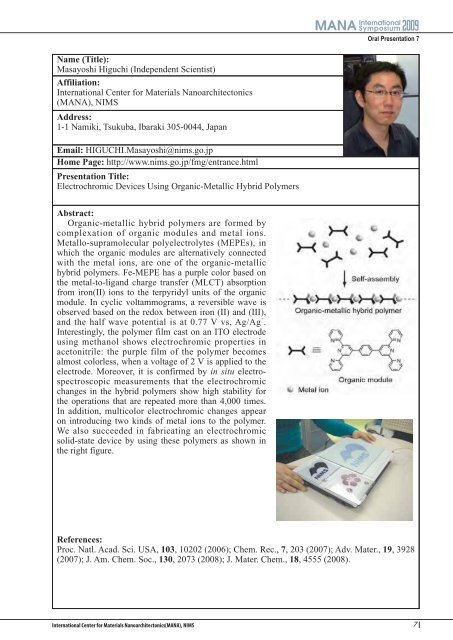Abstract Download (8.38MB)
Abstract Download (8.38MB)
Abstract Download (8.38MB)
Create successful ePaper yourself
Turn your PDF publications into a flip-book with our unique Google optimized e-Paper software.
Name (Title):<br />
Masayoshi Higuchi (Independent Scientist)<br />
Affiliation:<br />
International Center for Materials Nanoarchitectonics<br />
(MANA), NIMS<br />
Address:<br />
1-1 Namiki, Tsukuba, Ibaraki 305-0044, Japan<br />
Email: HIGUCHI.Masayoshi@nims.go.jp<br />
Home Page: http://www.nims.go.jp/fmg/entrance.html<br />
Presentation Title:<br />
Electrochromic Devices Using Organic-Metallic Hybrid Polymers<br />
<strong>Abstract</strong>:<br />
Organic-metallic hybrid polymers are formed by<br />
complexation of organic modules and metal ions.<br />
Metallo-supramolecular polyelectrolytes (MEPEs), in<br />
which the organic modules are alternatively connected<br />
with the metal ions, are one of the organic-metallic<br />
hybrid polymers. Fe-MEPE has a purple color based on<br />
the metal-to-ligand charge transfer (MLCT) absorption<br />
from iron(II) ions to the terpyridyl units of the organic<br />
module. In cyclic voltammograms, a reversible wave is<br />
observed based on the redox between iron (II) and (III),<br />
and the half wave potential is at 0.77 V vs, Ag/Ag + .<br />
Interestingly, the polymer film cast on an ITO electrode<br />
using methanol shows electrochromic properties in<br />
acetonitrile: the purple film of the polymer becomes<br />
almost colorless, when a voltage of 2 V is applied to the<br />
electrode. Moreover, it is confirmed by in situ electrospectroscopic<br />
measurements that the electrochromic<br />
changes in the hybrid polymers show high stability for<br />
the operations that are repeated more than 4,000 times.<br />
In addition, multicolor electrochromic changes appear<br />
on introducing two kinds of metal ions to the polymer.<br />
We also succeeded in fabricating an electrochromic<br />
solid-state device by using these polymers as shown in<br />
the right figure.<br />
Oral Presentation 7<br />
References:<br />
Proc. Natl. Acad. Sci. USA, 103, 10202 (2006); Chem. Rec., 7, 203 (2007); Adv. Mater., 19, 3928<br />
(2007); J. Am. Chem. Soc., 130, 2073 (2008); J. Mater. Chem., 18, 4555 (2008).<br />
7















